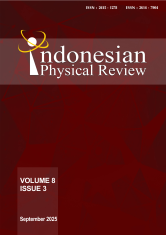INTEGRATED GEOPHYSICAL AND GEOTECHNICAL ANALYSIS TO SUBSURFACE LITHOLOGY OVERVIEW AT ITERA DORMITORY SITE, LAMPUNG, INDONESIA
DOI:
10.29303/ipr.v8i3.488Downloads
Abstract
The Student Dormitory is a gathering place for most new students at ITERA. For disaster mitigation, it is necessary to conduct geophysical and geotechnical surveys. Geophysical and geotechnical surveys are conducted to describe the subsurface lithology. The purpose of this study is to identify the subsurface of the Dormitory building so that it can be determined which buildings have the potential for geological hazards. The methods used are geomagnetic, geoelectric and geotechnical methods. The results obtained are that High and low magnetic anomalies are related to the thickness of the lithology. This is also justified by the results of geoelectric using resistivity cross-sections. The thickness of this lithology is related to the level of building security. TB4 has the highest security based on magnetic and geoelectric data. Meanwhile, TB1 has the lowest security based on subsurface conditions.Keywords:
Geoelectrical Magnetic CPT Hazard LithologyReferences
Wang, "Condition Assessment of Building Foundation in Karst Terrain Using both Electrical Resistivity Tomography and Multi-channel Analysis Surface Wave Techniques", Geotechnical Geological Engineering, 2019.
Masudi, "Identifikasi Kedalaman Lapisan Tanah Keras Menggunakan Metode Geolistrik Tahanan Jenis (Studi Kasus: Jalan Perdana Kota Pontianak)", Jurnal Ilmu dan Inovasi Fisika, 2021.
M. Marchetti, L. Cafarella, D. Di Mauro, & A. Zirizzotti, "Development of Geophysical Test Sites and Its Impacts on Research and Education Activities", Bulletin of Engineering Geology and the Environment, 2023.
A. S. Adewoyin, M. A. Oladunjoye, & A. P. Aizebeokhai, "Seismic refraction and geotechnical methods for near-surface characterization of a proposed building site", Journal of Applied Geophysics, 165, 1–10, 2019.
A.A. Khoirunida, Rochman, S.A. Bahri, "Identification of Subsurface for Grounding Installation System Using Geoelectrical Method: Case Study of Waru Substation, Sidoarjo, East Java", BIO Web of Conferences, 2025.
Rahmawati, Dian and Zulfian, "Identifikasi Lapisan Tanah Keras pada Lahan Gambut Menggunakan Metode Geolistrik Tahanan Jenis", PRISMA FISIK, 2020.
Supriyadi et al, "Struktur Lapisan Bawah Permukaan dan Zona Potensi Amblesan Daerah Wisata Kota Lama Semarang Berdasarkan Data Geolistrik", Prosiding Seminar Nasional Fisika, 2020.
F. I. Siddiqui, & S. B. A. B. S. Osman, "Geoelectric and Mineralogical Studies for Foundation Soil Characterization in New Luxor City, Upper Egypt", Arabian Journal of Geosciences, 2022.
Pazha et al., "The Identification of Hard Bottom Surface Structure using Correlation of Geoelectrical Resistivity Methods and SPT Data as Preliminary Studies for Laying the Foundation at Passing Cross Sumatera Toll Road, South Lampung Station", Journal of Physics, 2019.
Rizka, S. Satiawan, "Bedrock Investigation using Resistivity Method as an effort to Provide Subsurface Data at ITERA Campus", Journal of Science and Applicative Technology, 2019.
O. J. Akitorinwa, S. T. Oluwole, "Empirical relationship between electrical resistivity and geotechnical parameters: A case study of Federal University of Technology campus, Akure SW, Nigeria", NRIAG Journal of Astronomy and Geophysics, 2018.
A. M. Teshome, "Application of Magnetic Method to Characterize Abaya Campus Building Site, Southern Ethiopia", Journal of Geology & Geophysics, 11(1), 1013, 2022.
J.P.G.N. Rochman, W.N. Buwonokeling, M.H.M. Fajar, A. Hilyah, et al., " Comparison of Airborne Magnetic and Ground Magnetic for Identification of Sub-surface Condition Study Case Sand Caldera of Bromo-Tengger Volcanic Complex: Preliminary Study", IOP Conference Series: Earth and Environmental Science, 2024.
A. M. Haifani, "Developing new relationship between Standard Penetration Test (SPT), Cone Penetration Test (CPT), and sleeve friction in various soil types", Journal of Hunan University Natural Sciences, 50(1), 1–10, 2023.
L. Monforte, M. Arroyo, & A. Gens, "A relation between undrained CPTu results and the state parameter for liquefiable soils", arXiv, 2023.
C.-H. Hsiao, E. M. Rathje, & K. Kumar, "Investigating the effect of CPT in lateral spreading prediction using Explainable AI", arXiv, 2025.
E. Bol, A new approach to constructing SPT–CPT correlation for sandy soils. Georisk: Assessment and Management of Risk for Engineered Systems and Geohazards, 17(2), 1–15, 2023.
N. N. Pujianiki & I. N. Simpen, "Aplikasi geolistrik pada pemetaan daerah intrusi air laut di Pantai Candidasa", MEDIA KOMUNIKASI TEKNIK SIPIL, 24(1), 1–7, 2018.
A. H. F. Rizqi, W. Winarti, M. Erlandi, & D. Diyoko, Penyelidikan geolistrik sebagai survei awal pembangunan kolam renang di daerah Towangsan, Gantiwarno, Klaten, Jawa Tengah, KURVAMAS, 1(1), 1–6, 2024.
I. Suyanto & P. Susilanto, "Tomografi geolistrik untuk identifikasi litologi pada lokasi rencana bendung dan terowongan di Sulawesi Utara", Jurnal Meteorologi dan Geofisika, 17(1), 15–23. 26, 2016.
A. Ariyanto, "Identifikasi sesar Cimandiri segmen Cidadap menggunakan metode geolistrik resistivitas konfigurasi dipole–dipole dan Schlumberger", Wahana Fisika, 8(1), 116–126, 2022.
M. A. Oladunjoye, M. J. Salami, A. P. Aizebeokhai, O. A. Sanuade, & S. A. Kaka, "Geoelectrical resistivity and seismic refraction methods for near-surface characterization of a proposed conference center site", Journal of Applied Geophysics, 146, 1–10, 2017.
A. P. Aizebeokhai, E. O. Oyeyemi, & A. A. Joel, "Geoelectrical resistivity method for foundation stability assessment: A case study of a proposed building site", Journal of Applied Geophysics, 133, 1–10, 2016.
E. O. Oyeyemi, A. P. Aizebeokhai, & M. A. Oladunjoye, "Geoelectrical resistivity method for soil characterization in engineering site investigations", Journal of Applied Geophysics, 118, 1–10, 2015.
E. O. Oyeyemi, M. A. Oladunjoye, A. P. Aizebeokhai, A. O. Ajekigbe & O. O. Ogunfolakan, "Geoelectrical resistivity method for near-surface characterization of a proposed building site", Journal of Applied Geophysics, 118, 1–10, 2015.
A. P. Aizebeokhai, E. O. Oyeyemi, & A. A. Joel, "Geoelectrical resistivity method for foundation stability assessment: A case study of a proposed building site", Journal of Applied Geophysics, 133, 1–10, 2016.
S. Rahmati Kamel, M. Almasian, & M. Pourkermani, "Review and Analysis of Geological Structural Model by Using Geomagnetic, Case Study: Haji Abad Region in Iran’s Zagros Zone", Open Journal of Geology, 5(2), 15–29, 2015.
R. Bai, F. Shen, Z. Zhao, Z. Zhang, & Q. Yu, "The analysis of the correlation between SPT and CPT based on CNN-GA and liquefaction discrimination research", Computer Modeling in Engineering & Sciences, 138(2), 1159–1182, 2024.
L. Zhang & L. Zhang, "SPT–CPTU correlations and liquefaction evaluation for the island and tunnel project of the Hong Kong–Zhuhai–Macao Bridge", International Journal of Civil Engineering, 21(3), 1–12, 2023.
M. Alam, M. Aaqib, S. Sadiq, S. J. Mandokhail, M. B. Adeel, M.-u. Rehman, & N. A. Kakar, "Empirical SPT–CPT correlation for soils from Lahore, Pakistan", IOP Conference Series: Materials Science and Engineering, 414(1), 012015, 2018.
R. Rizka, B. A. Piskora, S. Satiawan, & H. Saputra, "Simulation of time-lapse resistivity method on sandbox model to determine fluid changes and desaturation", Journal of Geoscience, Engineering, Environment, and Technology, 5(4), 1–10, 2020.
S.A. Mangga et al., "Peta Geologi Lembar Tanjung Karang, Sumatra. Bandung : Pusat Penelitian dan Penembangan Geologi", Indonesia, 1993
P. K. Robertson, "Soil classification using the cone penetration test", Canada: Canadian Geotechnical Journal, 1990.
T. Yang, J. Gao, Z. Gu, et al. " Petrophysical Properties (Density and Magnetization) of Rocks from the Suhbaatar-Ulaanbaatar-Dalandzadgad Geophysical Profile in Mongolia and Their Implications", The Scientific World Journal, 2013.
C.A. de Matos, C.A. Mendoca, Poisson magnetization-to-density-ratio and magnetization inclination properties of banded iron formations of the Carajás mineral province from processing airborne gravity and magnetic data, Geophysics, 2020.
License

This work is licensed under a Creative Commons Attribution-NonCommercial-ShareAlike 4.0 International License.
Authors who publish with Indonesian Physical Review Journal, agree to the following terms:
- Authors retain copyright and grant the journal right of first publication with the work simultaneously licensed under a Creative Commons Attribution-ShareAlike 4.0 International Licence (CC BY SA-4.0). This license allows authors to use all articles, data sets, graphics, and appendices in data mining applications, search engines, web sites, blogs, and other platforms by providing an appropriate reference. The journal allows the author(s) to hold the copyright without restrictions and will retain publishing rights without restrictions.
- Authors are able to enter into separate, additional contractual arrangements for the non-exclusive distribution of the journal's published version of the work (e.g., post it to an institutional repository or publish it in a book), with an acknowledgment of its initial publication in Indonesian Physical Review Journal.
- Authors are permitted and encouraged to post their work online (e.g., in institutional repositories or on their website) prior to and during the submission process, as it can lead to productive exchanges, as well as earlier and greater citation of published work (See The Effect of Open Access).





